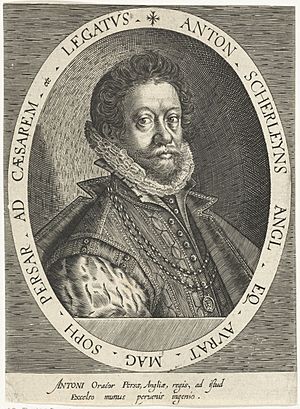Anthony Shirley facts for kids

Sir Anthony Shirley (1565–1635) was an English explorer and diplomat. He was known for his travels and missions to distant lands. In 1603, he was briefly held by King James I. This event led the English Parliament to declare that its members should be free from arrest. This important rule was written in a document called The Form of Apology and Satisfaction.
Contents
About Anthony Shirley's Family
Anthony Shirley was born into an important family. He was the second son of Sir Thomas Shirley of Wiston, Sussex. His mother was Anne Kempe. She was the daughter of Sir Thomas Kempe. Anthony had two brothers, Sir Thomas Shirley and Sir Robert Shirley. He also had six sisters.
Anthony Shirley's Adventures and Career
Anthony Shirley studied at the University of Oxford. He gained military experience fighting in the Netherlands. He also fought in Northern France in 1591. There, he showed great bravery at the Battle of Château-Laudran. Later that year, he fought under The 2nd Earl of Essex. The Earl was related to Shirley's wife, Frances Vernon.
Around this time, Henry of Navarre knighted him. Shirley fought with English and Swiss soldiers to support Henry. Henry was a Protestant leader fighting against the Catholic League. Shirley helped him during the Siege of Rouen. Because of his fighting skills, Shirley and another knight, Sir Nicolas Clifford, received French honors. This made their own king unhappy. They were briefly put in prison for it.
Expeditions to Africa and America
In 1596, Shirley led an expedition along the west coast of Africa. He then sailed to Central America. In 1597, he raided Spanish Jamaica. He had hoped to command a larger fleet. However, a mutiny (rebellion) among his crew forced him to return to London. He came back with only one ship in 1597.
Journey to Persia
In 1598, Shirley traveled to Italy. He went to help with a disagreement over land in Ferrara. But the issue was resolved by the time he arrived in Venice. So, he decided to travel to Persia. He had two main goals. He wanted to help England and Persia trade more. He also wanted to encourage the Persians to work against the Turks.
Shirley managed to get money in Constantinople and Aleppo. He was very well received by the Shah, Abbas the Great. The Shah even made him a Mirza, which means a prince. He also gave trading rights to all Christian merchants.
Diplomatic Missions in Europe
After his time in Persia, Shirley became the Shah's representative. He returned to Europe. He visited Moscow, Prague, Rome, and other cities. However, the English government did not allow him to return home. Two members of his expedition did go back to London. They published a pamphlet about Shirley's journey. This pamphlet, along with actor Will Kempe's meeting with Shirley in Rome, inspired Shakespeare. He mentioned "the Sophy" (the Shah) in his play Twelfth Night.
Shirley was held in prison in Venice for some time. In 1605, he went to Prague. There, Rudolph II, Holy Roman Emperor sent him on a mission to Morocco. Later, he traveled to Lisbon and Madrid. He was welcomed very warmly in Spain. The King of Spain made him an admiral of a fleet. This fleet was meant to serve in the Levant. But his large preparations only led to a failed mission against the island of Mitylene. After this, he lost his leadership role.
Shirley was also a count of the Holy Roman Empire. He passed away in Madrid sometime after 1635.
Shirley's Writings
Sir Anthony Shirley wrote about his own adventures. His book is called Sir Anthony Sherley: his Relation of his Travels into Persia (1613). The original copy of this book is kept at the Bodleian Library in Oxford. There are also several other accounts of Shirley's travels in Persia. His expedition in 1596 is described in Richard Hakluyt's Voyages and Discoveries. You can also read more about him in books like The Three Brothers and The Sherley Brothers.
See also

